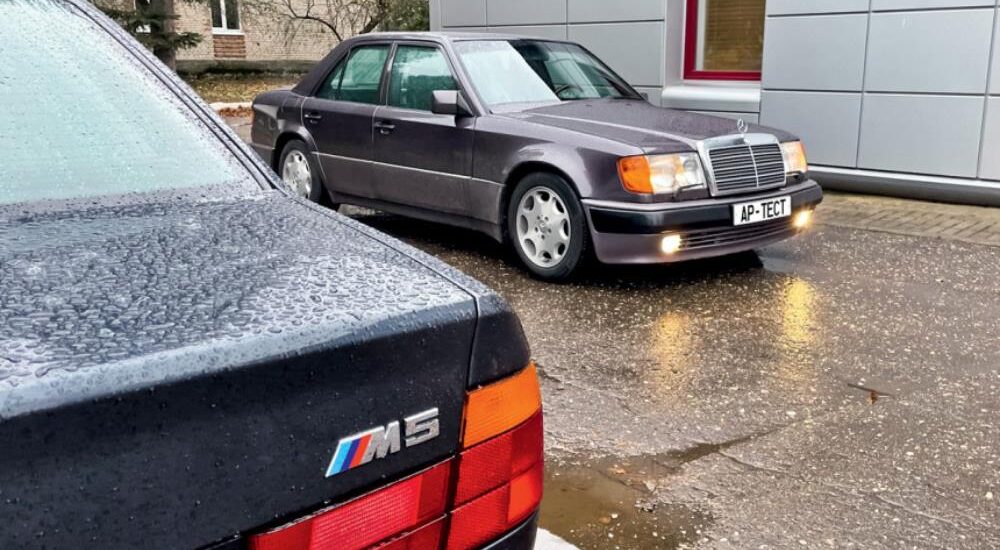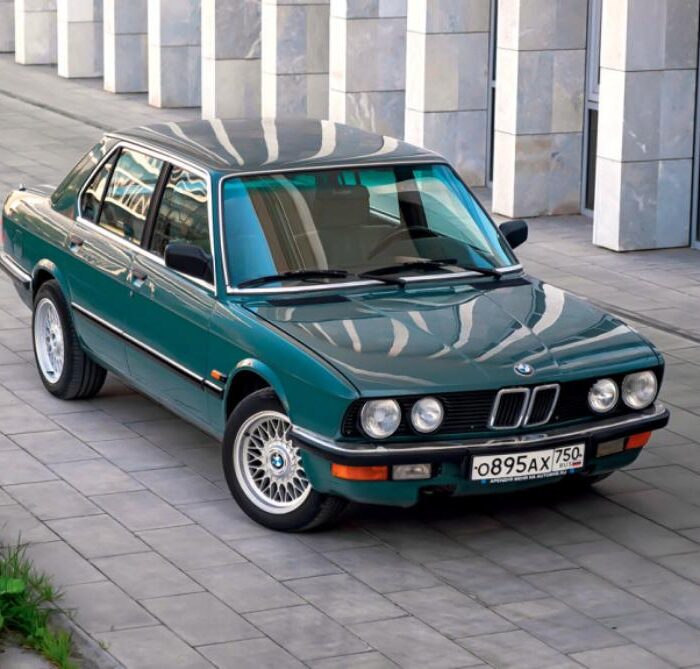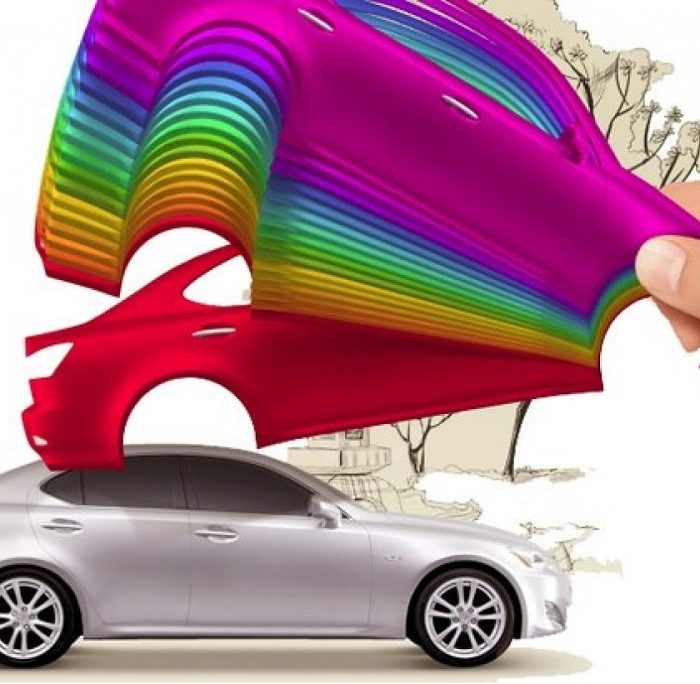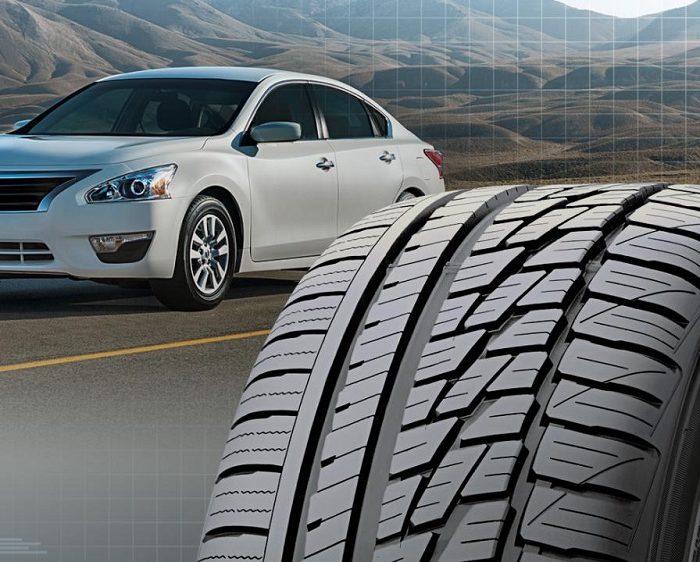Als Mercedes den W124 ankündigte, konterte BMW mit dem E34. Die Antwort aus München war laut und deutlich mit der Ankündigung des M5, und Stuttgart antwortete schnell mit dem 500 E. Interessanterweise hatten diese beiden Superlimousinen trotz ihrer großen Unterschiede einen gemeinsamen Ausgangspunkt – beide begannen ihre Reise in einer LKW-Karosserie.

Das Projekt W124 begann 1977 mit dem ersten Design von Peter Pfeiffer und Josef Gallitzendörfer und wurde vom Leiter des Styling-Zentrums, Bruno Sacco, fertiggestellt.
Der Ton der Rivalität wurde in den 1980er Jahren unbestreitbar von BMW vorgegeben, angetrieben von dem Ehrgeiz, Mercedes auszustechen. Der Wettbewerb war so hart, dass die Münchner ihre Anstrengungen verdoppeln mussten, um die Verfolgung aufrechtzuerhalten. Sie brauchten einen Durchbruch, um sich einen Vorsprung zu verschaffen, und der kam mit der Einführung des E32 “Seven” im Jahr 1986, gefolgt vom V12-angetriebenen BMW 750i ein Jahr später. Die Herausforderung bestand nun darin, diesen Erfolg mit dem “Fünfer” zu wiederholen.
Die 1988 auf den Markt gebrachten E34-Limousinen wurden mit einem einzigen Ziel gezüchtet: den beeindruckenden W124 zu übertreffen. Vier Jahre nach seinem Debüt war der Mercedes immer noch ein Wunderwerk der Automobiltechnik. Während unseres Retro-Tests habe ich mich in die BMW Praxis vertieft, einen Händlerkatalog, mit dem die Verkäufer auf den neuen “Fünfer” geschult wurden. Dieses 240-seitige Handbuch ist eine Fundgrube für Details über den E34, gefüllt mit Einblicken, die man sonst nur selten findet.
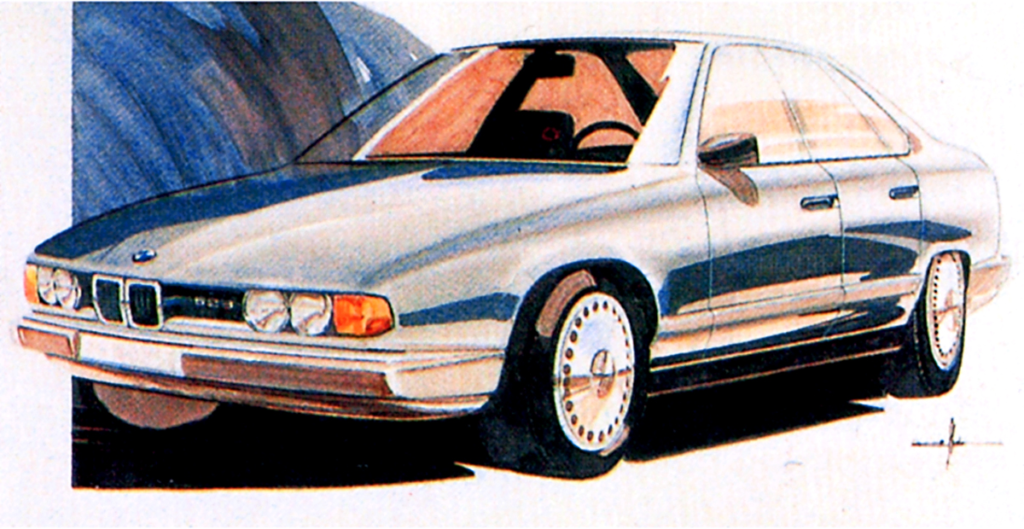
Die italienischen Gene des E34 wurden 1982 von Ercole Spada skizziert. Die Arbeit an den „Fünf“ wurde von Jay Mays fortgeführt und unter der Leitung von Klaus Luthe abgeschlossen.
Von Marketingstrategien bis hin zu technischen Innovationen war der Konkurrenzkampf groß. BMW analysierte die Marktanteile verschiedener Berufsgruppen und stellte eine Vorliebe für den “Propeller” bei Managern der mittleren Ebene und den “Star” bei Top-Managern und Freiberuflern fest. BMW warb auch mit Verbesserungen bei der Aerodynamik und behauptete, den Luftwiderstandsbeiwert gegenüber dem Vorgängermodell um 18 % verbessert und einen Wert von 0,30 erreicht zu haben, während das ikonische Kühlergrill-Design beibehalten wurde. Unterschwellig wurde angedeutet, dass die Ergebnisse noch besser hätten ausfallen können, wenn nicht die Standardreifen verwendet worden wären – ein Seitenhieb auf Mercedes, dessen beste aerodynamische Werte mit schmaleren Reifen erzielt wurden.

Die von BMW wahrgenommene Balance zwischen Funktionalität (vertikale Achse) und Ästhetik (horizontale Achse). Es stellt sich heraus, dass Lancia am wenigsten praktisch ist, während Audi als am wenigsten schön gilt.
Innovationen wie das einzigartige Wischersystem von Mercedes, das 86 % der Windschutzscheibe reinigte, wurden von BMW mit verlängerten Wischern beantwortet, die den gleichen Reinigungsbereich hatten, aber einen Mechanismus für eine bessere Wischleistung bei niedrigen Geschwindigkeiten aufwiesen. Während Mercedes mit einer automatischen Heizung für Spiegel und Düsen aufwartete, führte BMW einen beheizten Verriegelungsmechanismus ein, der durch das Festhalten des Türgriffs aktiviert wird – ein Merkmal durchdachter Technik.

Es ist offensichtlich, wie unterschiedlich Unternehmen mit dem Front-End gearbeitet haben. Bei Mercedes fungieren Optik und Kühlergrill als aerodynamisches Werkzeug zur Reduzierung des Auftriebs. Für BMW sind vor allem die Scheinwerfer das Gesicht der Marke. Dennoch liefert der BMW Praxiskatalog interessante Zahlen: Um den Luftwiderstand bei einer Geschwindigkeit von 180 km/h zu überwinden, benötigt der E34 64 PS, bei 200 km/h sind es 87 PS. Das sind 20 % weniger als beim Vorgängermodell E28 mit ähnlicher Haifischnase.
Jedes Modell führte Merkmale ein, die das andere übertreffen sollten. Die berühmte Fünflenker-Hinterradaufhängung von Mercedes traf auf die Verbesserungen des E34 durch BMW, einschließlich elektronisch gesteuerter Dämpfer und einer Servotronic-Lenkung. Auf das ASR von Mercedes antwortete BMW mit seinem fortschrittlichen ASC+MSR-System, das nicht nur die Traktion, sondern auch das Blockieren der Räder beim Verzögern berücksichtigt.
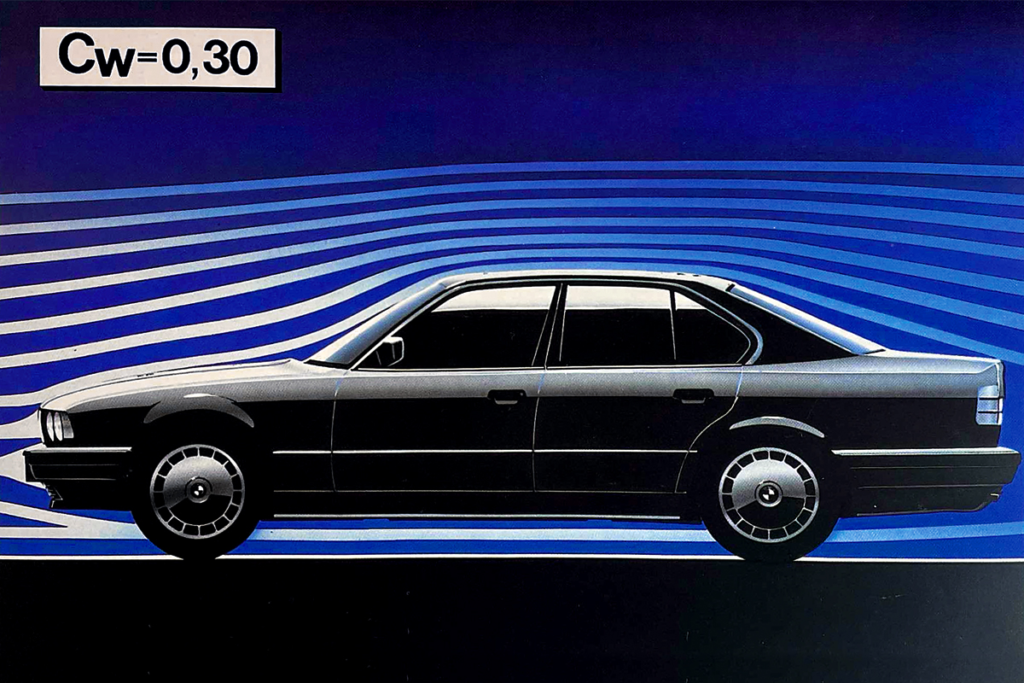
Der Katalog lieferte sogar eine Begründung für die Fahreigenschaften des M5, die besagt, dass BMW das Fahrwerk absichtlich auf ein neutrales bis leichtes Untersteuern abgestimmt hat, das bei Drosseleingaben in ein Übersteuern übergehen kann, vermutlich um der hecklastigen Natur des Mercedes entgegenzuwirken.
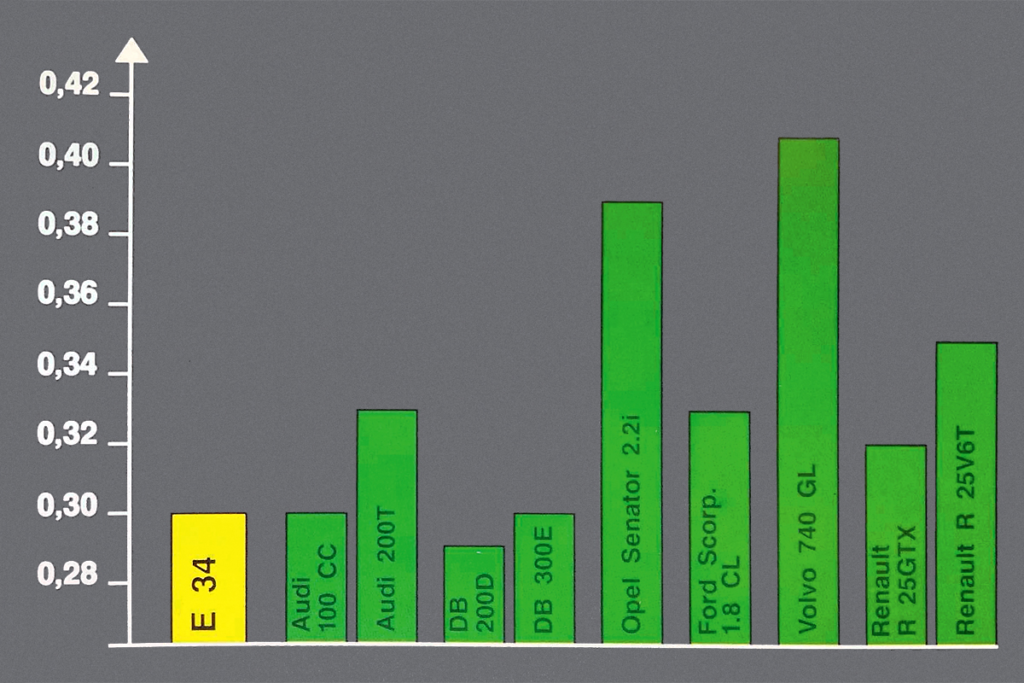
Die Aerodynamik von Klassikern und Zeitgenossen. Um zu Mercedes aufzuschließen, zog BMW Mitarbeiter von Audi ab.
Dieser ständige Kampf um die Vorherrschaft brachte nicht nur die technologischen Grenzen zum Vorschein, sondern unterstrich auch eine tief verwurzelte Rivalität. Obwohl der E34 den W124 kurzzeitig überholte, konnte er die revolutionäre Wirkung des V12 E32 nicht wiederholen. Obwohl er sich die Plattform mit dem “Siebener” teilte, schien der “Fünfer” immer einen Schritt hinter seinem Stuttgarter Pendant zurückzubleiben, da er Innovationen wie dem Allradantrieb und Sicherheitsverbesserungen hinterherjagte, bei denen Mercedes Pionierarbeit geleistet hatte.
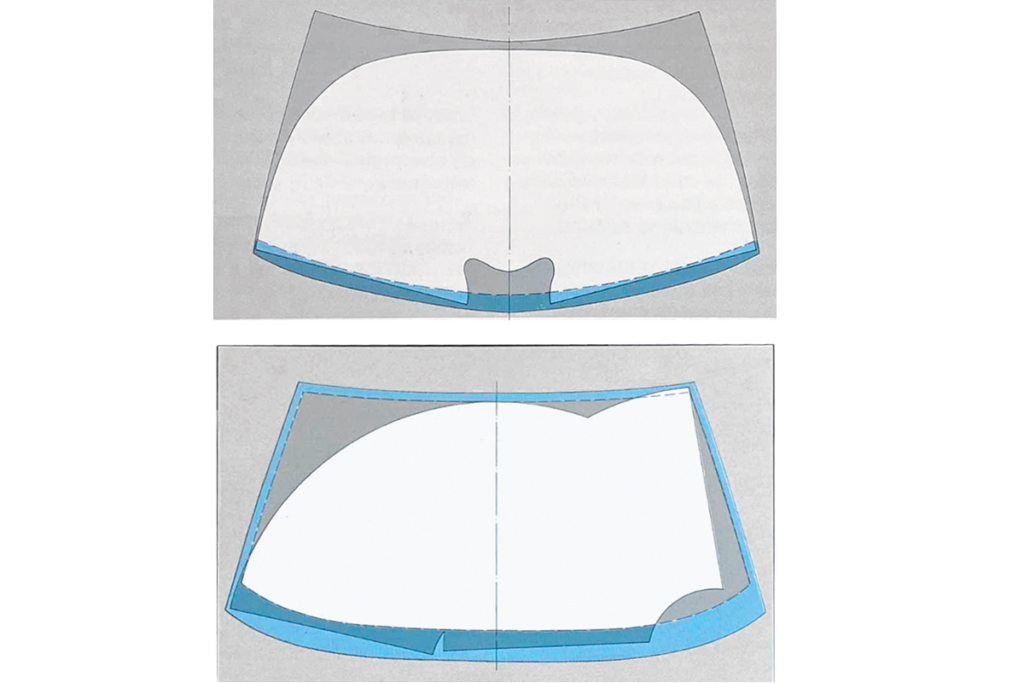
Der Scheibenwischer von Mercedes erreicht die oberen Ecken und bietet eine rekordverdächtige Windschutzscheiben-Reinigungsfläche in der Automobilindustrie. BMW betont, dass die obere linke Ecke für die Sichtbarkeit an der Ampel wichtiger sei.
Der BMW M5 ist ein Zeugnis dieses harten Wettbewerbs und verkörpert das unerbittliche Streben nach automobiler Spitzenleistung und Innovation. Während diese Rivalen sich gegenseitig zu immer größeren Leistungen anspornten, hinterließen sie ein Vermächtnis an technischer Leistung und Performance, das die Automobilwelt bis heute inspiriert.
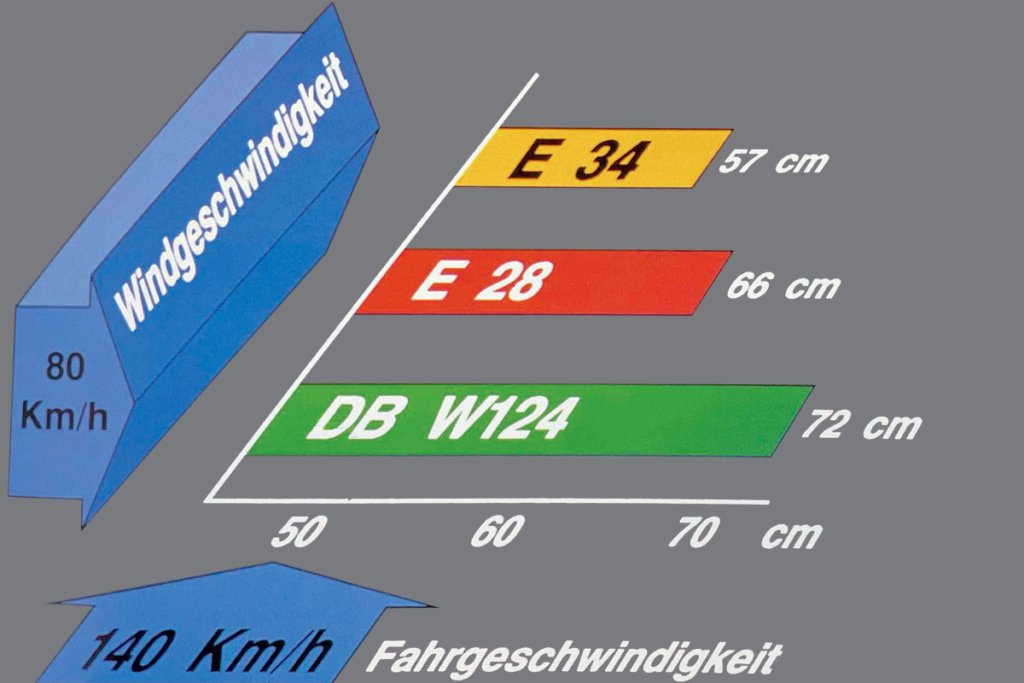
Ein weiterer Grund, die Überlegenheit gegenüber Mercedes hervorzuheben: Bei Seitenwind driftet der E34 weniger als der W124.
Als Mercedes den W124 vorstellte, reagierte BMW schnell mit dem E34 und läutete damit sein eigenes Meisterwerk, den M5, ein. Das Stuttgarter Gegenstück, der 500 E, markierte den Beginn einer faszinierenden Rivalität zwischen zwei völlig unterschiedlichen Superlimousinen, die beide einen überraschenden Ursprung haben: Jedes Modell begann sein Leben auf einem LKW-Fahrgestell.
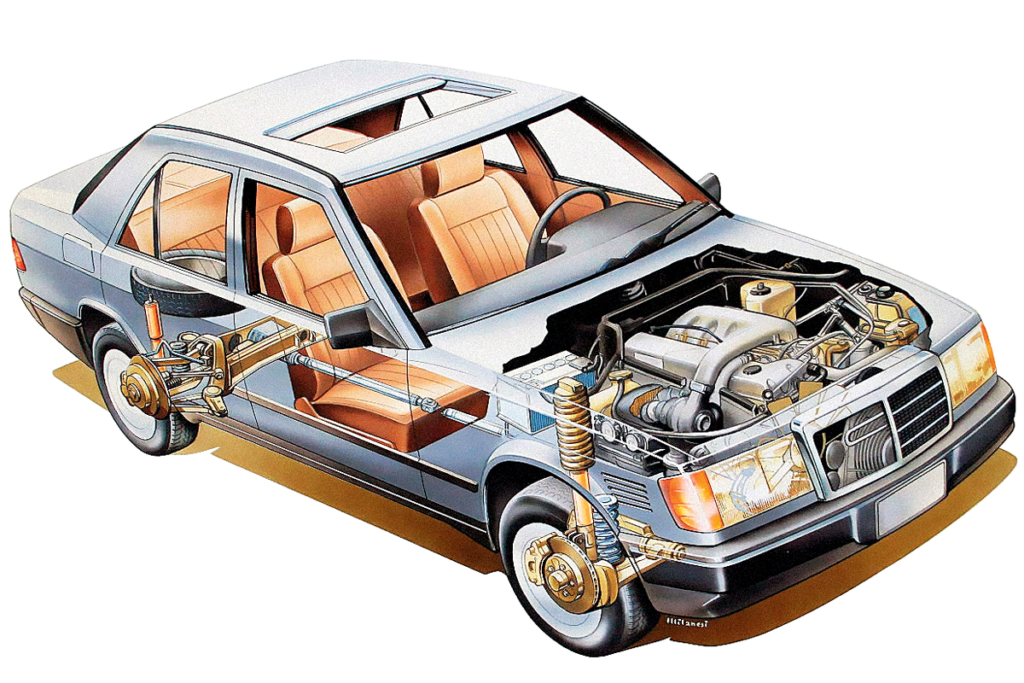
Das wichtigste technische Schmuckstück des W124-Chassis ist die Mehrlenker-Hinterradaufhängung, die etwas früher bei der kleineren Limousine W201 auftauchte und später in fast allen Mercedes-Pkw eingebaut wurde. Es wurde von vielen anderen Herstellern kopiert. Mit Modifikationen wird dieses grundlegende Fünf-Link-Schema auch heute noch verwendet.
In den 1980er Jahren versuchte BMW mit aller Macht, Mercedes zu übertreffen. Die Stuttgarter waren beeindruckend und zwangen die Münchener, ihre Anstrengungen zu verdoppeln, um mithalten zu können. Um Mercedes zu übertreffen, brauchte BMW etwas Außergewöhnliches. Das gelang 1986 mit dem Debüt des E32 “Seven”, und ein Jahr später versetzte der BMW 750i mit seinem V12-Motor die Automobilwelt in Erstaunen. Die Herausforderung bestand darin, diesen Erfolg mit dem “Five” zu wiederholen.
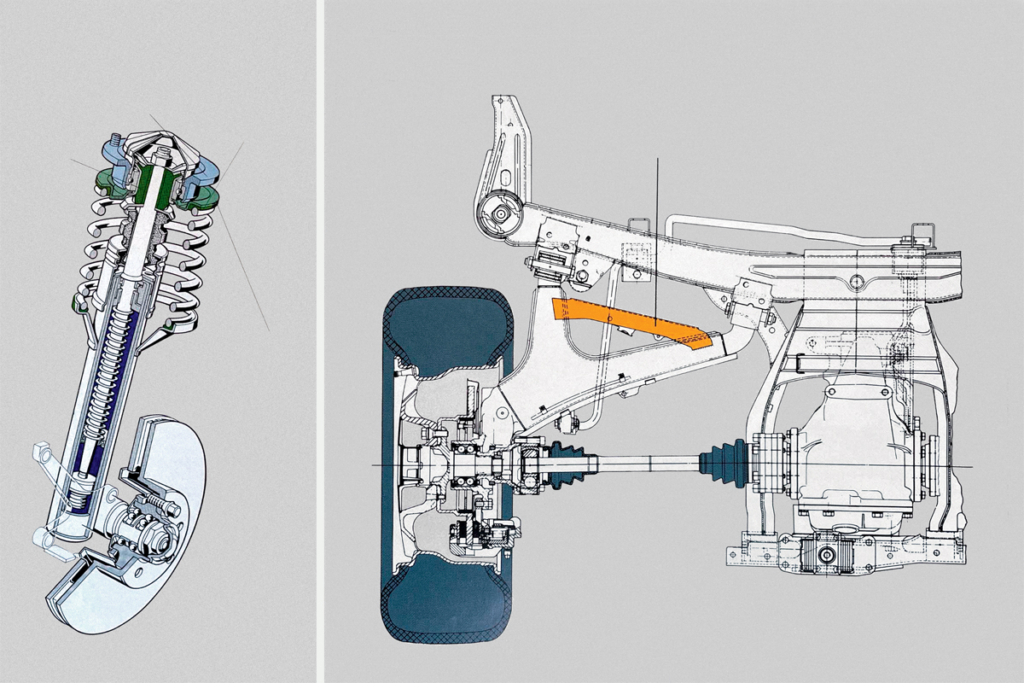
Für alle E34-Versionen oberhalb des BMW 525i und 524td wurden McPherson-Federbeine mit separater Feder- und Stoßdämpferhalterung geliefert. Hinten wurden die Schrägarme mit Streben verstärkt. Dies war der letzte „Fünfer“ mit solch einer Old-School-Hinterachse. Als Option wurde, außer für den M5, ein strafferes Sportfahrwerk angeboten.
Die 1988 eingeführten E34-Limousinen waren auf ein Ziel ausgerichtet – den herausragenden W124. Vier Jahre nach seinem Debüt verkörperte der Mercedes immer noch den Zenit der Automobiltechnik.
Während unserer retrospektiven Tests verbrachte ich mehrere Tage mit einem einzigartigen Händlerkatalog, der BMW Praxis, der für die Schulung des Verkaufspersonals über den neuen “Fünfer” entwickelt wurde. Diese 240 Seiten starke Bibel des E34 deckt jedes kleinste Detail und jede Designentscheidung des Fahrzeugs ab. Sie ist vollgepackt mit einzigartigen Einblicken und hat einen Preis von 30.000 Rubel – ein Beweis für ihren Wert. Bemerkenswert ist, dass der W124 auf fast jeder Seite erwähnt wird, was eine offensichtliche Besessenheit unterstreicht.
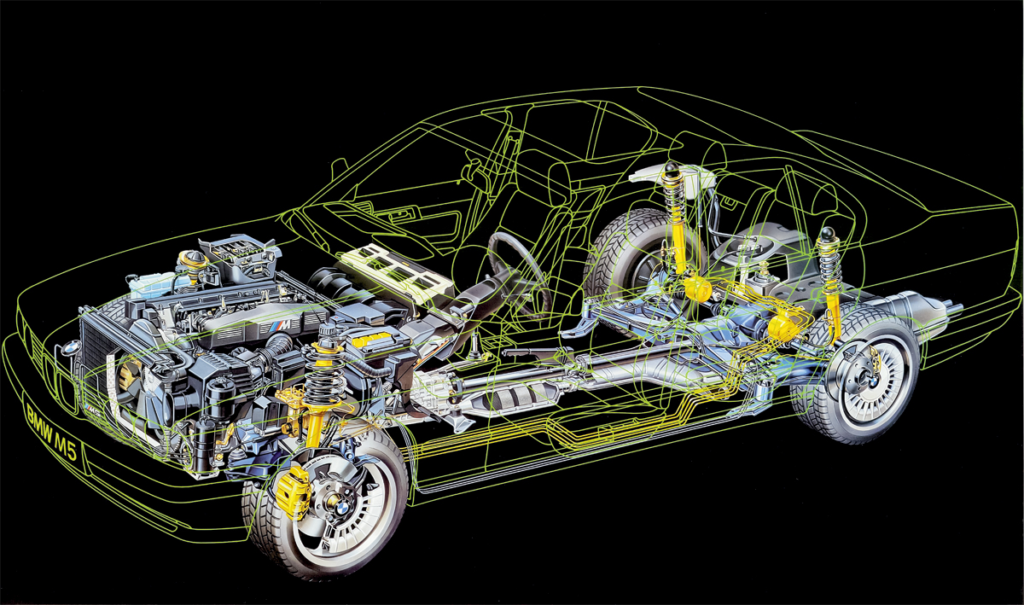
Die vergleichbare komplexe Mehrlenkeraufhängung von BMW erschien erst 1989 beim E31-Coupé und dann beim „Siebener“ E38 und „Fünfer“ E39. Doch war der M5 E34 schon vor der Markteinführung des Mercedes 500 E serienmäßig mit hinteren Stoßdämpfern ausgestattet, die über einen hydraulischen Niveauregulierungsmechanismus verfügten, um einen konstanten Sturzwinkel und eine konstante Bodenfreiheit der Räder aufrechtzuerhalten.
Der Kampf begann mit Marketingstrategien, wobei BMW detaillierte Marktanteilsvergleiche für verschiedene Berufsgruppen anstellte. Die Marke “Propeller” fand mehr Anklang bei mittleren Managern, während der “Star” bei Top-Managern und Freiberuflern beliebt war. BMW prahlte auch mit technischen Meisterleistungen und behauptete, die Aerodynamik gegenüber dem Vorgängermodell deutlich verbessert zu haben und einen Luftwiderstandsbeiwert von 0,30 zu erreichen, wobei die ikonische negative Neigung der Nasenlöcher erhalten blieb. Es wurde subtil angedeutet, dass diese Ergebnisse noch besser hätten ausfallen können, indem darauf hingewiesen wurde, dass Konkurrenten wie Mercedes schmalere Reifen verwendeten, um optimale Werte zu erreichen.
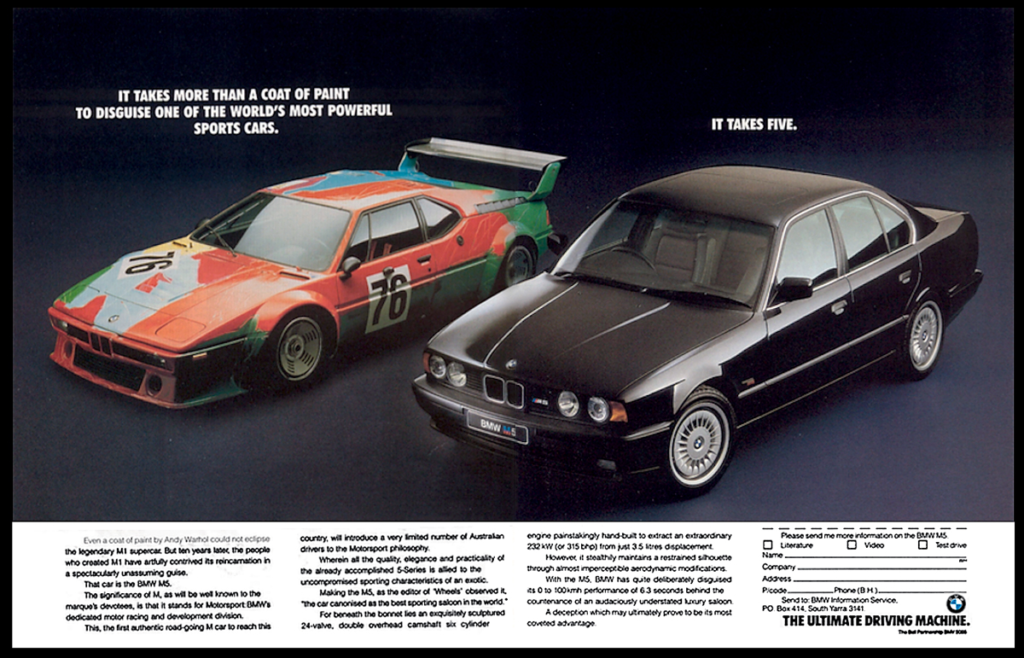
Die Abstammung der M5-Motoren geht traditionell auf den „Sechser“ M88 des BMW M1 zurück, obwohl der wahre Vorläufer der BMW 3.0 CSL war. Die M88/3-Version ohne Trockensumpfschmierung wurde in Europa dem E28 M5 zugeteilt, während der erste Motor mit der Bezeichnung S38B35 die „katalytische“ Version für Amerika war. Die S38-Motoren des E34 erbten einen Eisenblock und einen 24-Ventil-DOHC-Kopf.
BMW entsprach dem innovativen Scheibenwischersystem von Mercedes, das 86 % der Scheibe reinigte, indem es die Reichweite der Scheibenwischer verlängerte und einen Mechanismus an der Basis hinzufügte, um die Haftung der Wischerblätter bei niedrigen Geschwindigkeiten zu verbessern. Außerdem wurde eine einzigartige Funktion eingeführt, bei der durch Ziehen und Halten des Türgriffs eine Schlossheizung aktiviert wird – eine clevere Ergänzung für kältere Klimazonen.
Von den klappbaren hinteren Kopfstützen, die durch Servos statt durch Federn betätigt werden, bis hin zu einem ausgeklügelten Traktionskontrollsystem, das sowohl den Verlust der Bodenhaftung als auch plötzliche Verzögerungen bewältigt, schien BMW entschlossen, nicht nur konkurrenzfähig, sondern auch führend in Sachen Innovation zu sein. Jedes Modell versuchte, das andere zu übertreffen, und BMW verfeinerte sein Design ständig, um auf die Fortschritte von Mercedes zu reagieren.
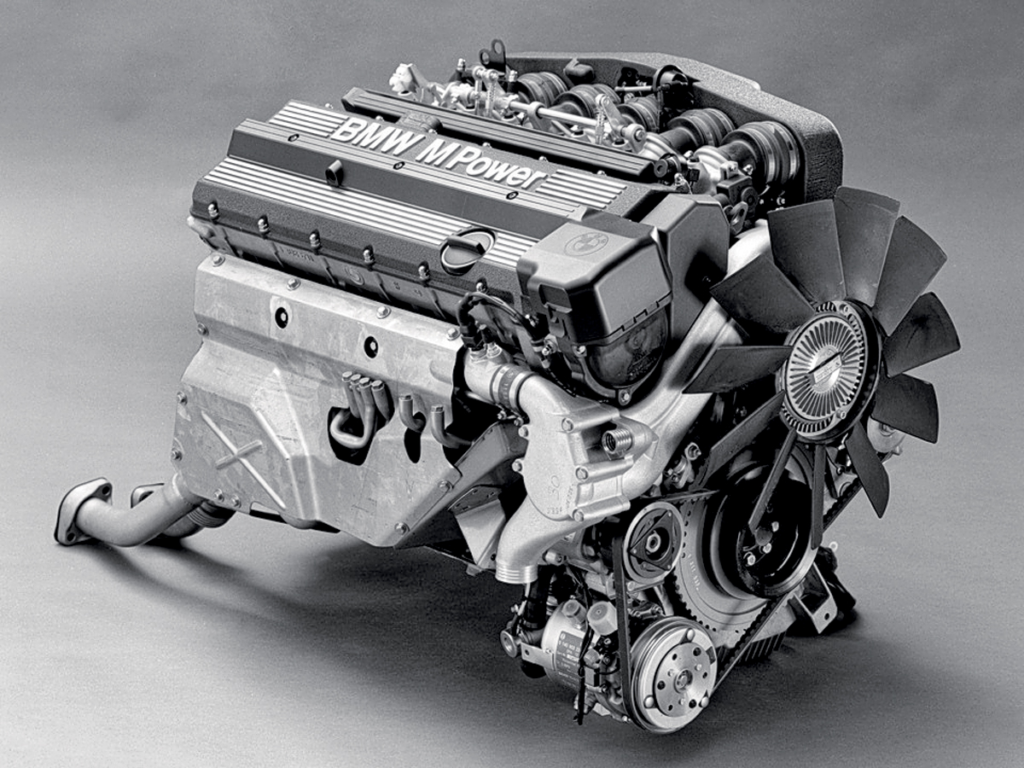
Der S38B36-Motor (315 PS) des M5 vor dem Facelift hatte tatsächlich einen Hubraum von 3535 ccm, erhielt aber die Bezeichnung 3.6, um ihn vom Vorgängermotor mit 3453 ccm Hubraum im M5 E28 zu unterscheiden.
Der BMW-Katalog lieferte zudem eine Begründung für die Fahreigenschaften des M5, die auf ein bewusstes neutrales bis leichtes Untersteuern hinwiesen, das beim Beschleunigen in ein Übersteuern übergehen konnte – vielleicht eine Anspielung auf den “treibenden” Charakter des “124”.
Dieser Zweikampf brachte nicht nur die Grenzen der Automobiltechnik zum Vorschein, sondern unterstrich auch den intensiven Wettbewerbsgeist zwischen den beiden Marken. Der E34 lag zwar kurzzeitig vor dem W124, konnte aber nicht an die bahnbrechende Wirkung des E32 mit zwölf Zylindern anknüpfen. Obwohl er sich die Plattform mit dem “Siebener” teilte, war der “Fünfer” immer auf der Verfolgungsjagd und führte Innovationen wie Kombi-Karosserien, Allradantrieb und verbesserte Sicherheitsmerkmale ein, die an die von Mercedes eingeführten anknüpften. Der BMW M5 bleibt ein Denkmal für diese harte Rivalität und zeigt, wie der Wettbewerb Innovation und Spitzenleistung in der Automobilindustrie vorantreibt.
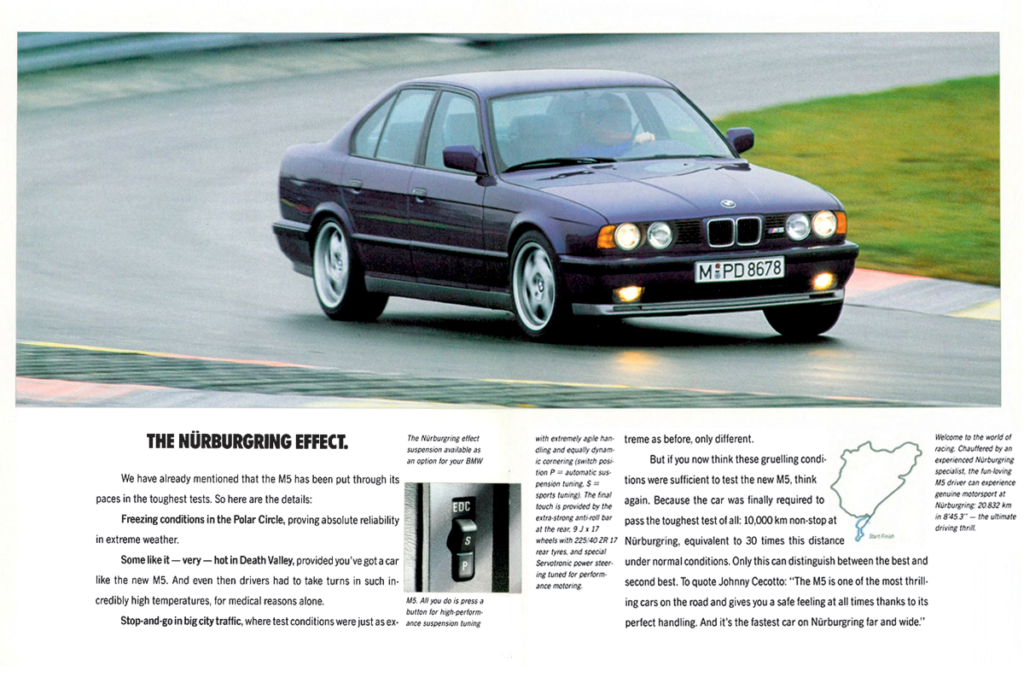
Der Nürburgring-Effekt führt dazu, dass die BMW M5 Limousine mit adaptiven EDC-Stoßdämpfern bei Tests ohne Unterbrechung zehntausend Kilometer auf der Nordschleife des Nürburgrings zurücklegte und dabei die beste Zeit von 8:45,3 Minuten (auf einer 20,832 km langen Strecke) erzielte.
Vor drei Jahren, zum 30-jährigen Jubiläum des Mercedes 500 E, veröffentlichte der Pressedienst von Porsche ein Interview mit Michael Hölscher, dem Projektleiter des Typ 2758. Hölschers anschließende Podcast-Auftritte beleuchteten die Entwicklungsnuancen dieses Kultmodells weiter. Er stellte klar, dass das Layout der Limousine, die Wahl des Motors und des Getriebes aus dem 500 SL Roadster sowie das Design und die Aerodynamik ausschließlich von Mercedes bestimmt wurden. Porsche war in erster Linie mit der Integration dieser Komponenten in das W124-Chassis betraut, das ursprünglich nicht für die Aufnahme von V8-Motoren ausgelegt war.
Diese Zusammenarbeit erforderte erhebliche Anpassungen, darunter die Verlegung von Ansaugkanälen, die Neuverlegung von Brems- und Kraftstoffleitungen, Anpassungen des Mitteltunnels, eine Verbreiterung der Strecke und die Durchführung eines umfangreichen Fahrversuchsprogramms. Interessanterweise verzichtete Mercedes bei diesem Projekt auf ein Nürburgring-Tuning, was unterstreicht, dass die Vorgaben des Kunden für Porsche von größter Bedeutung waren.
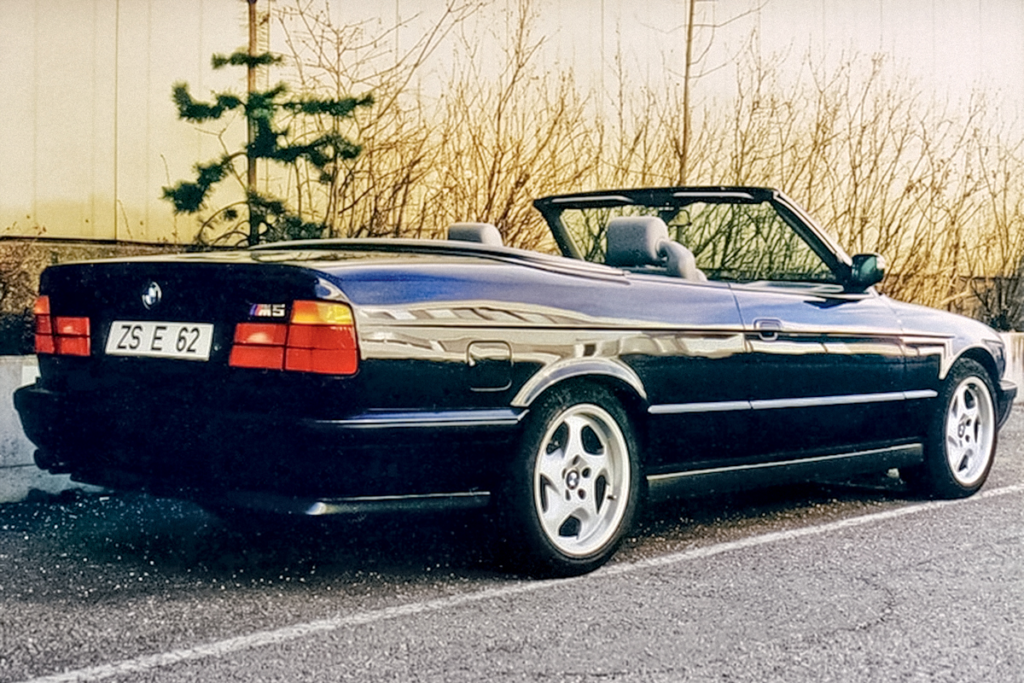
Auf dem Genfer Autosalon 1989 sollte eigentlich ein M5-Cabrio mit E35-Karosserie gezeigt werden, doch eine Woche vor der Premiere befürchtete BMW eine negative Nachfrage nach dem offenen M3 und sagte das Projekt ab. Der Prototyp wurde erst 2009 vorgestellt.
Eine bemerkenswerte Innovation aus Zuffenhausen war die Entwicklung des elektronischen Motormanagementsystems. Der 500 E war sowohl für Mercedes als auch für Porsche wegweisend, denn er war das erste Fahrzeug, das mit einem CAN-Bus-System ausgestattet war.
Hölscher räumte auch mit dem Mythos auf, dass der 500 E wegen seiner zu breiten vorderen Kotflügel, die Gerüchten zufolge von Porsche entworfen wurden, nicht auf dem Sindelfinger Montageband untergebracht werden konnte. Er erklärte, dass diese Kotflügel in Wirklichkeit von Mercedes-Designern entworfen wurden, die sich der Zwänge des Fließbandes durchaus bewusst waren. Die Entscheidung, die Anlagen im Werk Sindelfingen nicht für breitere Kotflügel umzurüsten, sondern bestimmte Produktionsschritte an Porsche auszulagern, war eine kosteneffiziente Strategie. Das wirft eine interessante Frage auf: Vielleicht wollte Mercedes diese besondere Limousine an einem einzigartigen Ort abseits der normalen Produktionslinien montieren, ähnlich wie BMW es getan hat.
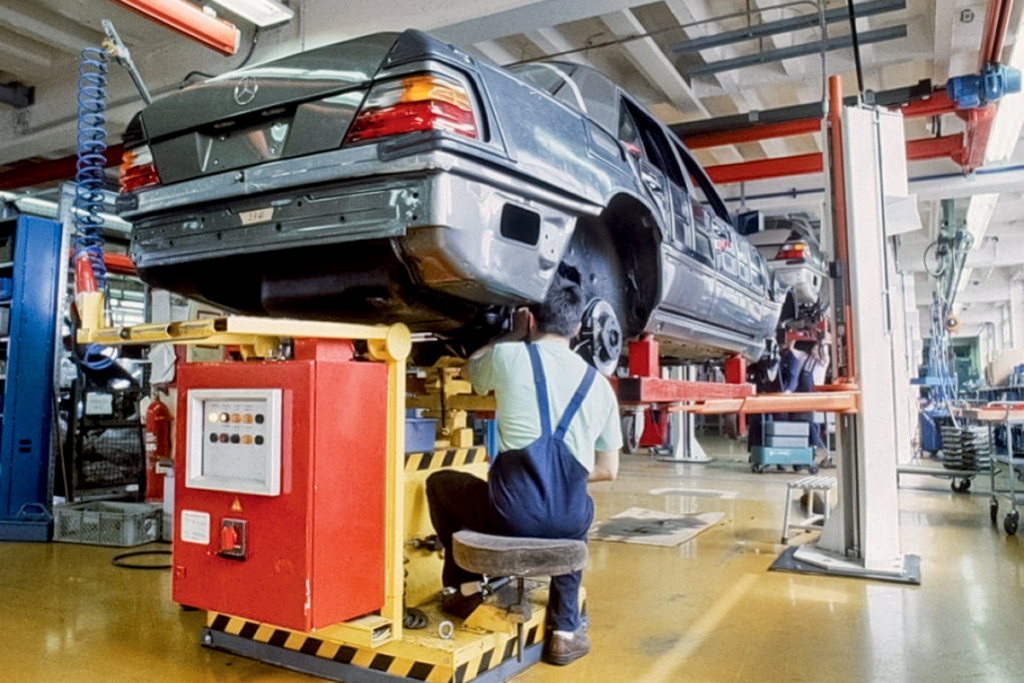
Im Porsche-Werk wurden Mercedes-Autos ohne Fließband, sondern auf Hebebühnen und Karren montiert. Der VIN-Code dieser Autos sollte die Zahlen 124.036 enthalten.
Letztlich wurde der Mercedes 500 E an drei Standorten montiert. Gestanzte Karosseriebleche wurden per Lkw von Sindelfingen nach Zuffenhausen transportiert, wo Porsche Teile hinzufügte und sie im Reutter-Bau-Gebäude zu Rahmen zusammensetzte – benannt nach dem historischen Reutter-Karosseriewerk, einer Karosseriewerkstatt, die seit 1906 mit Ferdinand Porsche zusammenarbeitete und eine wichtige Rolle bei den frühen Porsche-Karosserien spielte. Nach der Erstmontage wurden die Rahmen zur Lackierung nach Sindelfinden und anschließend zurück nach Zuffenhausen zur Endmontage ins Rössle Bau Werk gebracht, in dem zuvor der Porsche 959 produziert wurde.
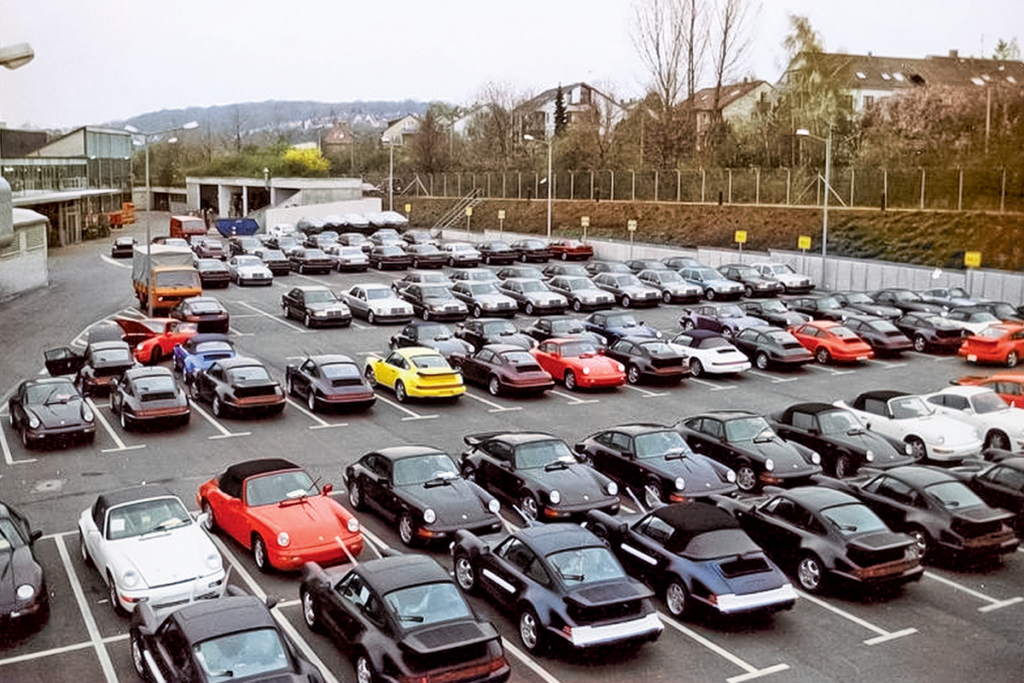
Anfang der 90er Jahre, die fertigen Produkte im Werk Zuffenhausen: verschiedene Porsche 964 und vierzig Mercedes im Hintergrund.
Die logistische Komplexität dieses Prozesses war beträchtlich; die Herstellung jedes Fahrzeugs dauerte 18 Tage. Trotzdem erwies sich der Produktionsprozess als effizienter als der des BMW M5. Ursprünglich hatte Mercedes geplant, dass Porsche täglich zehn Fahrzeuge produzieren sollte, doch aufgrund der überwältigenden Nachfrage verdoppelte sich die Produktionsrate.
Mit einem Preis von 135.000 D-Mark über dem der S-Klasse und einem Höhepunkt der Nachfrage und Produktion im Jahr 1992 wurde der 500 E im Rahmen des Facelifts 1993, das die gesamte Baureihe 124″ in die E-Klasse umwandelte, bald zum E 500. Obwohl die Technik gleich blieb, führte die Preiserhöhung auf 146.000 Mark zu einem Absatzrückgang, der 1995 in der Einstellung der Produktion gipfelte. Der weniger leistungsstarke 400 E (später E 420) wurde jedoch bis 1996 in doppelter Stückzahl weiter produziert.
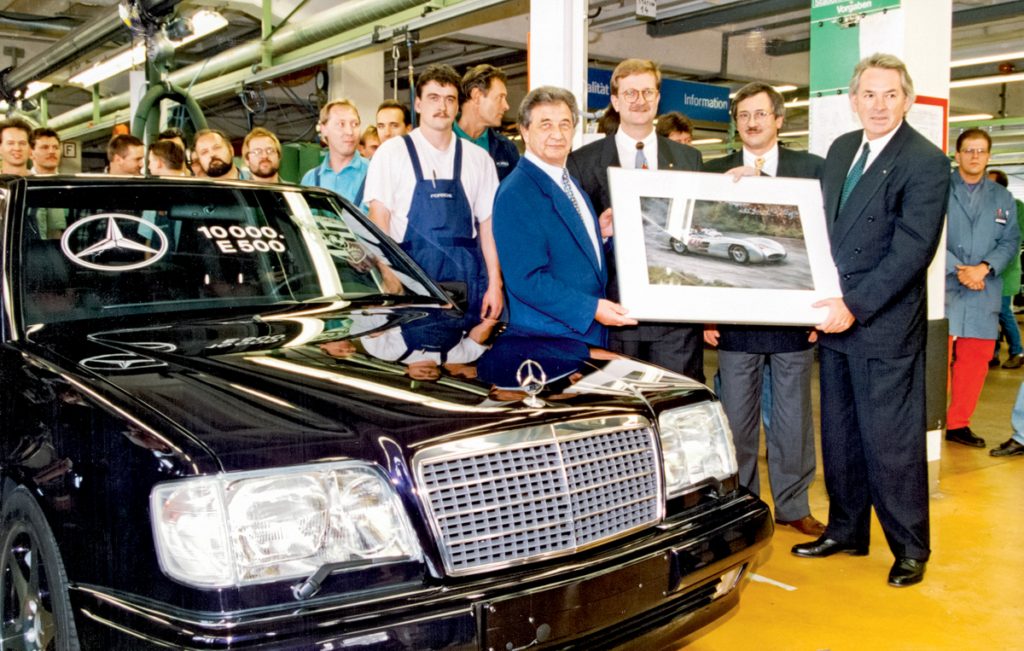
Der 10.000ste „Fünfhundert“-Mercedes wurde im Oktober 1994 produziert – bereits mit dem modellgepflegten Kennzeichen E 500. Danach wurden weitere 479 Einheiten montiert. Das Auto war ein Geschenk an Hans Herrmann, der in den 50er-Jahren für Mercedes in der Formel 1 fuhr und 1970 für Porsche das allererste Le Mans-Rennen gewann.
Dieses Projekt stabilisierte nicht nur die finanzielle Situation von Porsche, sondern stellte auch die Weichen für zukünftige Projekte wie den Audi RS2, bei dem Porsche einen größeren technischen Einfluss ausübte. Michael Hölschers Führungsrolle ging über dieses Projekt hinaus und trug zur Entwicklung des Carrera GT und des Porsche 918 Spyder bei, bevor er 2016 in den Ruhestand ging.
Mercedes erkannte mit dem Projekt 500 E den lukrativen Charakter von Hochleistungsmodellen und beschloss 1993, diesen “Kaviar” der Automobilbranche exklusiv zu halten. Dies führte zur Veröffentlichung des ersten Mercedes C 36 AMG und legte den Grundstein für zukünftige Hochleistungsinnovationen, die heute gut bekannt sind.
Foto: BMW | Mercedes-Benz | Sergey Znaemsky
Dies ist eine Übersetzung. Den Originalartikel können Sie hier lesen: Dies ist der zweite Weltkrieg: Wie der BMW M5 und der Mercedes-Benz 500 E aus unserem Rückblick hervorgingen

Veröffentlicht Juni 20, 2024 • 13 m zum Lesen

